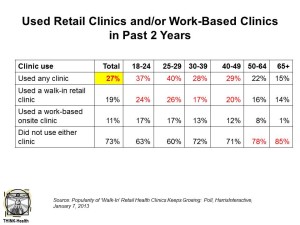 The use of retail and work-site health clinics is up, and their consumers skew young. Overall, 27% of all U.S. adults have stepped into a walk-in clinic in the past two years. But only 15% of people 65 and over have used such a clinic.
The use of retail and work-site health clinics is up, and their consumers skew young. Overall, 27% of all U.S. adults have stepped into a walk-in clinic in the past two years. But only 15% of people 65 and over have used such a clinic.
This begs the question: are retail and on-site clinics at the workplace filling the role of medical homes for younger adult Americans?
The Harris Interactive/HealthDay poll published in January 2013 discovered that use of retail clinics grew from 7% in 2008 to 27% in 2012. The largest age cohort using walk-in clinics is people between 18 and 29 years of age.
Most users of retail and work-based clinics are satisfied with the care delivered at these provider settings: 82% said they were satisfied, very satisfied, or extremely satisfied with retail clinics; 73% of work-site clinic consumers were at least satisfied, very satisfied, or extremely satisfied with their services. Only 6% and 12% of clinic users were not at all satisfied with retail and work-based sites, respectively.
What drives satisfaction for users of these clinics are convenience factors: no need to schedule an appointment, accessible locations, short wait times, open when doctor is closed, insurance acceptance, cheaper, and — for 20% of retail clinic users — the fact they don’t have a primary doctor.
The most common complaints motivating visits to walk-in clinics by retail and work-based sites were:
- Cold and flu symptoms, among 38% and 29%
- To get a flu shot, 32% and 43%
- Need prescription for medication, 30% and 27%
- Cut or wound, 19% and 26%
- General check up, 15% and 38%
- Sprained a joint or broke a bone, 14% and 21%
- Checked cholesterol or blood pressure, 13% and 31%
- Bad headache or migraine, 13% and 20%
- Check up for chronic condition like diabetes or asthma, 5% and 13%.
HarrisInteractive surveyed 3,036 U.S. adults over 18 years of age in December 2012.
Health Populi’s Hot Points: One of the most striking findings in this survey is that the vast majority of consumers of walk-in clinics, 86% for retail clinics and 91% for work-site clinics, were enrolled in health insurance programs at the time of visiting the clinic. Combine this statistic with the projection of a primary care physician shortage coupled with younger people more regularly using these clinics for primary care complaints, and you can envision the role of this setting as an adjunct for medical homes.
It’s also important to call out the higher percentage of work-site clinic use for population health management and health checks for conditions like diabetes and asthma, cholesterol and blood pressure checks, and 38% of those using work-site clinics doing so for general check ups. The segment of employers offering work-site clinics are doing so in part to bolster employee health management beyond cuts and bruises — the Old School form of onsite clinics. This new approach to worker health leverages the immediacy of the work-site clinic to drive employee health in a 24×7 mode, not episodically. Employers who adopt the use of retail and onsite clinics also do so to lower the total cost of employee care by driving prevention and early detection of disease, and care in lower-cost settings (e.g., avoiding emergency room visits).
Walk-in clinics at the work-site, in shopping and strip-malls, at schools and universities — where people live, work, and play — bolster the health ecosystem and the concept of health care, everywhere. If underpinned with interoperable electronic health records, these clinics will be important players in accountable and value-based health care.
A postscript: Forbes on January 15 2013 talks about employers’ role in health care cost management. Here’s a link to the piece, which highlights the growing adoption of consumer-directed and especially high-deductible health plans. Work-site and retail clinics can lower costs for both employee-consumers and employers.





 Grateful to Gregg Malkary for inviting me to join his podcast
Grateful to Gregg Malkary for inviting me to join his podcast  This conversation with Lynn Hanessian, chief strategist at Edelman, rings truer in today's context than on the day we recorded it. We're
This conversation with Lynn Hanessian, chief strategist at Edelman, rings truer in today's context than on the day we recorded it. We're